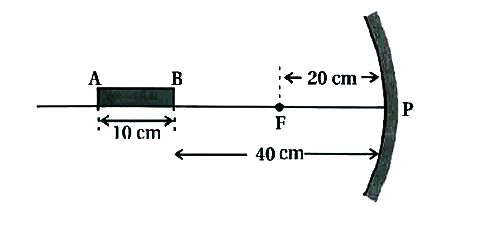Light from a point source in air falls on a spherical glass surface (n = 1.5 and radius of curvature = 20 cm). The distance of the light source from the glass surface is 100 cm. At what position the image is formed?Solution in Gujrati
Radius of curvature of curved surface R =20 cm
Refractive index of medium
Refractive index of air
Object distance U = - 100 cm
Equation of refraction by curved surface
Thus, image will be obtained at 100 cm distance from surface in direction of incident ray.
Topper's Solved these Questions
- RAY OPTICS AND OPTICAL INSTRUMENTSBOOK - KUMAR PRAKASHANCHAPTER - RAY OPTICS AND OPTICAL INSTRUMENTSEXERCISE - SECTION-B (NUMERICALS)(NUMERICAL FROM TEXTUAL EXERCISE)
45 Videos
- RAY OPTICS AND OPTICAL INSTRUMENTSBOOK - KUMAR PRAKASHANCHAPTER - RAY OPTICS AND OPTICAL INSTRUMENTSEXERCISE - SECTION-B (NUMERICALS)(NUMERICAL FROM .DARPAN. BASED ON TEXTBOOK )
12 Videos
- RAY OPTICS AND OPTICAL INSTRUMENTSBOOK - KUMAR PRAKASHANCHAPTER - RAY OPTICS AND OPTICAL INSTRUMENTSEXERCISE - SECTION - A (TRY YOURSELF)
74 Videos
- MOVING CHARGES AND MAGNETISMBOOK - KUMAR PRAKASHANCHAPTER - MOVING CHARGES AND MAGNETISMEXERCISE - SECTION D (MCQs ASKED IN COMPETITIVE EXAMS)
34 Videos
- SAMPLE QUESTION PAPER BOOK - KUMAR PRAKASHANCHAPTER - SAMPLE QUESTION PAPER EXERCISE - PART-B SECTION-C
5 Videos
Similar Questions
A small candle, 2.5 cm in size is placed at 27 cm in front of a concave mirror of radius of curvature 36 cm. At what distance from the mirror should a screen be placed in order to obtain a sharp image? Describe the nature and size of the image. If the candle is moved closer to the mirror, how would the screen have to be moved?
View SolutionAs shown in the figure, a thin rod AB of length 10 cm is placed on the principal axis of a concave mirror such that it.s end B is at a distance of 40 cm from the mirror. If the focal length of the mirror is 20 cm, find the length of the image of the rod

View SolutionGive range of wavelength of visible light.
View SolutionElectric charge Q having mass M moves on a circular path of radius R with velocity →v, perpendicular to uniform magnetic field B. When a particle completes one revolution, work done by the field is _______
View SolutionTwo charges –q and +q are located at points (0, 0, –a) and (0, 0, a), respectively.
(a) What is the electrostatic potential at the points (0, 0, z) and (x, y, 0) ?
(b) Obtain the dependence of potential on the distance r of a point from the origin when r/a>>1 .
(c) How much work is done in moving a small test charge from the point (5,0,0) to (–7,0,0) along the x-axis? Does the answer change if the path of the test charge between the same points is not along the x-axis?
View SolutionLight from a point source in air falls on a spherical glass surface. If mu = 1.5 , and radius of curvature = 20 cm , the distance of light source from the glass surface is 100 cm , at what position will the image be formed ? (NCERT Solved Example)
View Solutionवायु में रखे किसी बिंदु स्रोत के प्रकाश काँच के किसी गोलीय पृष्ट पर पड़ता है | ( n = 1.5 तथा वक्रता त्रिज्या = 20 cm ) प्रकाश स्रोत की काँच के पृष्ट से दूरी ह 100 cm है | प्रतिबिम्ब कहा बनेगा ?
View Solutionवायु में रखे किसी बिन्दु स्रोत से प्रकाश काँच के किसी गोलीय पृष्ठ पर पड़ता है। (μ = 1.5 तथा वक्रता त्रिज्या = 20 सेमी) । प्रकाश स्रोत की काँच के पृष्ठ से दूरी 100 सेमी है। प्रतिबिम्ब कहाँ बनेगा ?
View SolutionAn image is formed at a distance of 100 cm from the glass surface when light from point source in air falls on a spherical glass surface with refractive index 1.5. The distance of the light source from the glass surface is 100 cm. The radius of curvature is
View SolutionAn image is formed at a distance of 100 cm from the glass surface when light from point source in air falls on a spherical glass surface with refractive index 1.5. The distance of the light source from the glass surface is 100 cm. The radius of curvature is
View SolutionLight from a point source in air falls on a spherical glass surface (n = 1.5 and radius of curvature = 20 cm ). The distance of the light source from the glass surface is 100 cm. At what position the image is formed ?
View SolutionLight from a point source in air falls on a spherical glass surface (n = 1.5 and radius of curvature = 20 cm ). The distance of the light source from the glass surface is 100 cm. At what position the image is formed ?
View SolutionLight from a point source in air falls on a spherical glass surface (n = 1.5 and radius of curvature = 20 cm). The distance of the light source from the glass surface is 100 cm. At what position the image is formed?
View SolutionLight from a point source in air falls on a spherical glass surface (n = 1.5 and radius of curvature = 20 cm). The distance of the light source from the glass surface is 100 cm. At what position the image is formed?
View SolutionLight from a point source in air falls on a spherical glass surface (n = 1.5 and radius of curvature = 20 cm). The distance of the light source from the glass surface is 100 cm. At what position the image is formed?
View Solution
